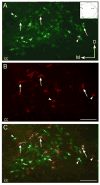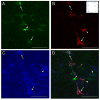Divergent projections of catecholaminergic neurons in the nucleus of the solitary tract to limbic forebrain and medullary autonomic brain regions
- PMID: 16962080
- PMCID: PMC1876790
- DOI: 10.1016/j.brainres.2006.08.051
Divergent projections of catecholaminergic neurons in the nucleus of the solitary tract to limbic forebrain and medullary autonomic brain regions
Abstract
The nucleus of the solitary tract (NTS) is a critical structure involved in coordinating autonomic and visceral activities. Previous independent studies have demonstrated efferent projections from the NTS to the nucleus paragigantocellularis (PGi) and the central nucleus of the amygdala (CNA) in rat brain. To further characterize the neural circuitry originating from the NTS with postsynaptic targets in the amygdala and medullary autonomic targets, distinct green or red fluorescent latex microspheres were injected into the PGi and the CNA, respectively, of the same rat. Thirty-micron thick tissue sections through the lower brainstem and forebrain were collected. Every fourth section through the NTS region was processed for immunocytochemical detection of tyrosine hydroxylase (TH), a marker of catecholaminergic neurons. Retrogradely labeled neurons from the PGi or CNA were distributed throughout the rostro-caudal segments of the NTS. However, the majority of neurons containing both retrograde tracers were distributed within the caudal third of the NTS. Cell counts revealed that approximately 27% of neurons projecting to the CNA in the NTS sent collateralized projections to the PGi while approximately 16% of neurons projecting to the PGi sent collateralized projections to the CNA. Interestingly, more than half of the PGi and CNA-projecting neurons in the NTS expressed TH immunoreactivity. These data indicate that catecholaminergic neurons in the NTS are poised to simultaneously coordinate activities in limbic and medullary autonomic brain regions.
Figures





Similar articles
-
Branching projections of catecholaminergic brainstem neurons to the paraventricular hypothalamic nucleus and the central nucleus of the amygdala in the rat.Brain Res. 1993 Apr 23;609(1-2):81-92. doi: 10.1016/0006-8993(93)90858-k. Brain Res. 1993. PMID: 8099526
-
Medullary visceral reflex circuits: local afferents to nucleus tractus solitarii synthesize catecholamines and project to thoracic spinal cord.J Comp Neurol. 1995 Jan 2;351(1):5-26. doi: 10.1002/cne.903510103. J Comp Neurol. 1995. PMID: 7534775
-
Collateral axonal projections from rostral ventromedial medullary nitric oxide synthase containing neurons to brainstem autonomic sites.Brain Res. 2008 May 23;1211:44-56. doi: 10.1016/j.brainres.2007.10.104. Epub 2007 Nov 17. Brain Res. 2008. PMID: 18423427
-
Role of the central nucleus of the amygdala in the control of blood pressure: descending pathways to medullary cardiovascular nuclei.Clin Exp Pharmacol Physiol. 2005 May-Jun;32(5-6):450-6. doi: 10.1111/j.1440-1681.2005.04210.x. Clin Exp Pharmacol Physiol. 2005. PMID: 15854157 Review.
-
Neurochemistry of bulbospinal presympathetic neurons of the medulla oblongata.J Chem Neuroanat. 2009 Nov;38(3):222-30. doi: 10.1016/j.jchemneu.2009.07.005. Epub 2009 Aug 7. J Chem Neuroanat. 2009. PMID: 19665549 Free PMC article. Review.
Cited by
-
The role of the gut-brain axis in alcohol use disorders.Prog Neuropsychopharmacol Biol Psychiatry. 2016 Feb 4;65:234-41. doi: 10.1016/j.pnpbp.2015.06.013. Epub 2015 Jul 16. Prog Neuropsychopharmacol Biol Psychiatry. 2016. PMID: 26188287 Free PMC article. Review.
-
Role of chemoreceptors in mediating dyspnea.Respir Physiol Neurobiol. 2009 May 30;167(1):9-19. doi: 10.1016/j.resp.2008.12.002. Epub 2008 Dec 11. Respir Physiol Neurobiol. 2009. PMID: 19118647 Free PMC article. Review.
-
Corticosterone inhibits vagal afferent glutamate release in the nucleus of the solitary tract via retrograde endocannabinoid signaling.Am J Physiol Cell Physiol. 2020 Dec 1;319(6):C1097-C1106. doi: 10.1152/ajpcell.00190.2020. Epub 2020 Sep 23. Am J Physiol Cell Physiol. 2020. PMID: 32966126 Free PMC article.
-
High glucose increases action potential firing of catecholamine neurons in the nucleus of the solitary tract by increasing spontaneous glutamate inputs.Am J Physiol Regul Integr Comp Physiol. 2017 Sep 1;313(3):R229-R239. doi: 10.1152/ajpregu.00413.2016. Epub 2017 Jun 14. Am J Physiol Regul Integr Comp Physiol. 2017. PMID: 28615161 Free PMC article.
-
The chemical neuroanatomy of breathing.Respir Physiol Neurobiol. 2008 Dec 10;164(1-2):3-11. doi: 10.1016/j.resp.2008.07.014. Respir Physiol Neurobiol. 2008. PMID: 18706532 Free PMC article. Review.
References
-
- Aicher SA, et al. Monosynaptic projections from the nucleus tractus solitarii to C1 adrenergic neurons in the rostral ventrolateral medulla: comparison with input from the caudal ventrolateral medulla. J Comp Neurol. 1996;373:62–75. - PubMed
-
- Allen GV, Cechetto DF. Functional and anatomical organization of cardiovascular pressor and depressor sites in the lateral hypothalamic area: I. Descending projections. J Comp Neurol. 1992;315:313–332. - PubMed
-
- Altschuler SM, et al. Viscerotopic representation of the upper alimentary tract in the rat: sensory ganglia and nuclei of the solitary and spinal trigeminal tracts. J Comp Neurol. 1989;283:248–268. - PubMed
-
- Buller KM, et al. NTS catecholamine cell recruitment by hemorrhage and hypoxia. Neuroreport. 1999;10:3853–3856. - PubMed
-
- Chan RK, Sawchenko PE. Hemodynamic regulation of tyrosine hydroxylase messenger RNA in medullary catecholamine neurons: a c-fos-guided hybridization histochemical study. Neuroscience. 1995;66:377–390. - PubMed
Publication types
MeSH terms
Substances
Grants and funding
LinkOut - more resources
Full Text Sources

